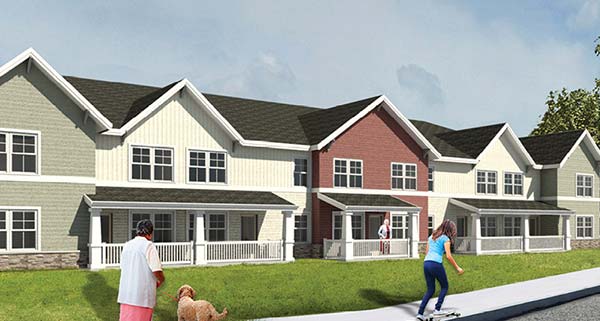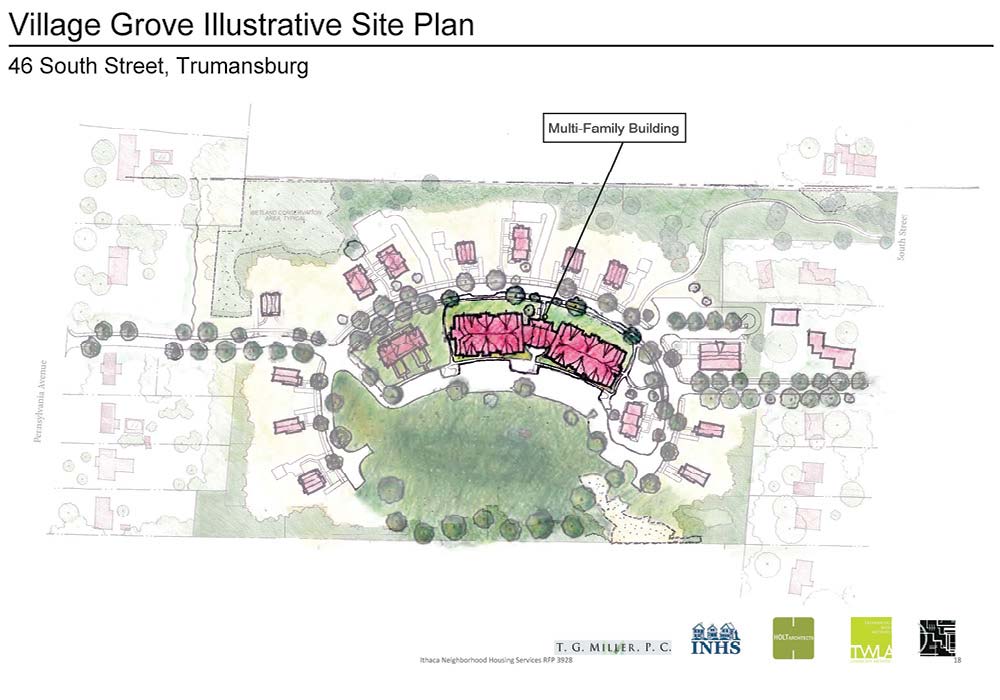Village Grove
Tompkins County

All-Electric, Affordable Housing With Passive House Design
Background
Village Grove is a 40-unit affordable multifamily rental building located at 46 South Street in the Village of Trumansburg, NY. It will be one of the first affordable multifamily buildings to utilize Passive House design and ground source heat pumps in the region. Village Grove is part of a larger proposed development in the Crescent Way subdivision.
The project will meet the Passive House Institute of the US (PHIUS)+ 2018 certification, participation in the NYSERDA New Construction—Housing program, and is pursuing all-electric heating, ventilation, and air conditioning (HVAC), and domestic hot water systems to eliminate fossil fuels on the property, contributing to a carbon neutral future. Innovative features include ground source heat pumps that will provide heating, cooling, and hot water, energy recovery ventilation, and participation in off-site community solar. Village Grove will serve as a model to other affordable housing developers of the financial, environmental, and social benefits of high-performance construction.
Key Project Features
Key high-performance building strategies in Village Grove include:
- HVAC: ground source heat pump (GSHP), energy recovery ventilation (ERV).
- Water Heating: Central water source heat pump (WSHP) (Daikin WHA060) from geothermal loop.
- Passive Design: PHIUS+2018 certification.
- Lighting Controls: Occupancy sensors.
- Appliances: ENERGY STAR.
- Renewables: Remote solar photovoltaic (PV) owned.


Rendering of Village Grove
Project Details
- Location: Trumansburg, New York
- Project Area: 46,614 sq. ft.
- Number of Buildings: 2
- Number of Stories Per Building: 2
- Number of Units: 40
- Project Cost: $121,942,998
- Cost per Gross Square Foot: $171.61
- Market Sector: Low-to-Moderate Income
- Construction Type: New Construction
- Construction Start Date: Summer 2022
- Completion Date: Construction in progress
- REDC Region: Southern Tier
- Developer: Ithaca Neighborhood Housing Services
- Architect & Design Team Lead: HOLT Architects & Sustainable Comfort, Inc.
- Technologies Used: GSHP, DHW, ERV, replicable panelized wall and floor system, cost-effective, PV, all-in-one rental and utility model
- Predicted Site Energy Use Intensity (EUI): 14.6 kBtu/SF/yr
- Net Site Energy Use Intensity (EUI): 0.0 kBtu/SF/yr
- Predicted Renewable Production Intensity (RPI): 14.6 kBtu/SF/yr
- Energy Code Baseline: 2020 NYS Energy Conservation Construction Code (ECCC)
- Performance Path: PHIUS+ 2018
- Certification: Green Communities Criteria, PHIUS+ Source Zero
Planning and Design Approach
Project Goals
The project team for Village Grove is committed to achieving PHIUS+ 2018 certification and will participate in the NYSERDA New Construction—Housing Net Zero program. The team has conducted energy modeling in both WUFI for Passive House and Ekotrope for Home Energy Rating System (HERS) Ratings to provide the team with the guidance needed to implement the PHIUS, ENERGY STAR, and NYSERDA programs. The project will achieve these targets with all-electric systems, a carefully designed building envelope, a high-performance ventilation system, and renewable energy generation. Utility use and costs will also be tracked across each unit.
Village Grove is part of the larger proposed Crescent Way development. Crescent Way is a residential mixed-use, mixed-income project sited on a 19-acre infill parcel. In addition to the two-story Village Grove multifamily building, the development will also consist of six affordable rental townhomes, ten affordable for-sale townhomes, a nursery school, and nine market-rate lots. This building will be one of New York State Homes and Community Renewal’s first projects to attain Passive House certification and utilize ground source heat pumps. The project will achieve Net Zero Energy performance through the purchase of off-site community solar. The project developers hope that this will serve as a model to other affordable multifamily developers of the financial, environment, and social benefits of high-performance construction.
Project Team
The project team includes forward-thinking consultants who have experience in high-performance building projects. The developer, Ithaca Neighborhood Housing Services (INHS), involved the full project team in design from an early stage. This included HOLT Architects as the architect team, Taitem Engineering as the mechanical, electrical, and plumbing (MEP) engineer, Sustainable Comfort as the energy modeler, and the general contractor Purcell Construction.
The team started with the goal of achieving Passive House Certification. After much discussion and research, the team narrowed the mechanical system options down to air source heat pumps with electric heat pump water heaters, or ground source heat pumps with an integrated hot water delivery system. The contractor priced both options, and INHS incorporated both costs into proformas with the community solar operating cost offsets. After discussion with the INHS property management division, INHS decided the ground source heat pump system was the best solution from an economic, energy efficiency, and long-term maintenance standpoint.
Building Design
Located within the quaint Village of Trumansburg, this project embraces the rich architectural pallet found throughout the area. Village Grove pulls its design cues from the surrounding rural houses and reimagines them within a more compact neighborhood. Amenities such as front yards, deep covered entry porches, gable roofs, ornamentation, colors, and detailing help to create an attractive streetscape. The building materials also mimic those found in the surrounding neighborhoods, using a variety of traditional lap siding, along with board and batten siding. Variation along the facade breaks down the scale of the Village Grove building into visually distinctive sections, reducing the overall mass to resemble a residential street.
The team is committed to green building strategies throughout the project and will target Enterprise Green Communities certification by meeting all mandatory criteria. Some of the relevant design considerations include compact density, stormwater management, open space preservation, transportation assistance, water-use reduction, enhanced plumbing design, advanced certification, renewable energy, materials selection, combustion elimination, radon mitigation, and smoke-free building.
This project will be an early adopter of a scalable design and construction technique through prefabricated manufactured interior walls and floor assemblies and exterior shell. The project team will use Purcell Construction to complete the building shell and interior floor and walls. Purcell is an experienced assembler/installer of panelized walls, their approach allows for pre-assembly in a controlled environment, standardizing the product and minimizing construction delays.
Energy Modeling
Sustainable Comfort has conducted energy modeling using both WUFI Passive V.3.2.0.1 for PHIUS+ 2018 certification and Ekotrope V.3.1.1.2183 for ENERGY STAR Multifamily New Construction Program v1.1. Using multiple modeling tools provides the team with the guidance needed to implement the PHIUS and ENERGY STAR certifications. Specifics of the modeling parameters include:
- Windows were modeled with a solar heat gain coefficient (SHGC) of 0.33 and U-factor of 0.18
- Walls were modeled as R-29, under slab insulation as R-4, and the roof as R-80
- The HVAC system was modeled to use the ground source heat pump (GSHP) system with Daikin Enfinity WSHPs in each unit with a heating coefficient of performance (COP) of 3.5 and an energy efficiency ratio (EER) of 25 for cooling
- RenewAire energy recovery ventilators (ERV) were modeled with 72% efficiency, and air leakage was modeled as 0.67 ACH50
- The central DHW system was also modeled as utilizing the GSHP system with two 5-ton water-to-water Daikin WHA060 heat pumps and 600 gallons of storage, resulting in an energy factor (EF) of 2.5
- Other loads modeled include 100% LED lighting, electric exhaust dryers, and induction stoves
- The building has a projected total electrical load of 199,400 kWh/yr, with solar PV panels off site projected to produce the full energy load for the building
Ekotrope modeling has been used to reflect guidance provided under the NYSERDA New Construction—Housing Net Zero program with a pre-photovoltaic (PV) HERS Index ranging from 36 to 39 and Post-PV HERS Index ranging from -1 to -4.
With all-electric heating and central Domestic Hot Water (DHW) systems, a super-tight envelope, and an efficient outdoor air ventilation system, the project is at the leading edge of efficient building design and can serve as a model for future buildings. The building meets all requirements for PHIUS+ 2018 Source Zero, has unit Energy Rating Index (ERI) values 40% to 45% better than ENERGY STAR, and serves as an example of hyper-efficient, all-electric, net zero building utilizing ground source energy.
Energy Efficient, All-Electric Design
High-Efficiency Lighting Fixtures and Appliances
Key high-efficiency features of the building and units will include:
- All water fixtures meeting the U.S. Environmental Protection Agency’s (EPA) WaterSense requirements
- ENERGY STAR® rated appliances
- LED lighting and occupancy installed sensors
- Outdoor lights on photocells
- Solar buildings ready and connected to off-site community solar at a solar farm
Building Envelope
Energy modeling has ensured that all heating, cooling, and primary energy targets for PHIUS+ 2018 are being met. The design team put careful consideration into the air sealing, windows, doors, and HVAC of the building. The building envelope will consist of R-80 roof insulation, R-15 slab edge insulation, and walls with R-12 continuous rigid insulation and 2x6 wood studs with R-21 cavity insulation. The tight building envelope results in less heat loss or gain and therefore the building’s energy needs and costs are lower than for a code-level insulated building.
For certification with PHIUS+ 2018 the project team is aiming to exceed the 0.06 CFM50 per square foot of enclosure requirement. The wall panels produced by Purcell will be constructed off-site in a controlled environment ensuring that the components are sealed to meet this requirement. Early and frequent pressure testing will help identify potential leakage paths, so they can be addressed in real time. Additionally, the project will include super-insulated triple-pane windows and doors. The layout and operation of the windows has been optimized for air tightness and energy efficiency.
The building will have two central ERV systems within the thermal envelope. They will serve each wing of the building to provide continuous filtered fresh air ventilation for building occupants. These units have a recovery efficiency of 72% and will remove stale air from kitchens, bathrooms, and corridors while providing fresh air to all rooms for balanced operation. Central units are located outside of the dwelling units, so the maintenance and repair can be completed without coordinating access with occupants. The central equipment will also require less maintenance cost than individual systems
All-Electric Systems
The design strategies deployed will allow for all-electric systems and therefore will not include any fossil fuel usage. All units will be served by the GSHP system, and the electrical load will be offset by renewable energy. In addition to heating and cooling, the GSHP technology will be used for domestic hot water, which will be distributed via a central loop with water-efficient distribution and fixtures in each apartment.
Renewable Energy
The project electrical load will be offset by developer-owned solar panels located remotely at a community solar farm. With the purchase of off-site solar PV, the project aims to achieve the PHIUS+ Source Zero certification. Final solar sizing will be based on the final energy modeling and testing results, with renewables predicted to meet building energy consumption of nearly 200 MWh/yr.
Smart Building Technologies
Resident outreach and transparency are important to the community. INHS will pay directly for all utility costs, and the project will implement utility monitoring to track electric usage for each unit. This information will be shared with building occupants to celebrate and raise awareness about the building’s efficiency features and to inspire behavioral shifts for tenants with higher-than-average usage.
The project will include an energy monitoring system and building management system, with tenant-level submetering to provide electricity data to occupants. Electricity, heating, and cooling in tenants’ units will be sub-metered, and DHW and water will be directly metered. This visibility will allow residents to understand their unit’s energy consumption, even as their electricity bills are paid by the owner and included in the rent.
Commissioning
"Village Grove will be a financially viable, carbon neutral project that provides a superior living environment for residents of modest means"
As-built drawings will be completed based on installed conditions throughout the project including all architectural and mechanical, electrical and plumbing (MEP) systems. The envelope will be inspected by Sustainable Comfort for insulation quality, and thermal imaging will be conducted at the end of the project to identify any inconsistencies with insulation or air-barrier installation. The final energy modeling will be revised to reflect as-built conditions and submitted to PHIUS for final certification to ensure the Passive House targets are met post-construction.
Leasing Structure
Village Grove is an affordable multifamily building where the owner will pay the utility costs for tenants. This is referred to as the “all in” rental model. Nevertheless, residents will still be provided with information on energy use in their unit to help them learn about opportunities for efficiency.
Cost Reduction
As compared with similar projects, Village Grove’s anticipated construction cost per bedroom is approximately 15% less. The difference is attributed to the use of prefabricated wall and floor panels by the general contractor. Additionally, Village Grove was designed as a two-story wood frame building on a concrete slab, gable roofs, and cementitious siding. The simplicity will make it easy to build and reduces the likelihood that the project will have any increased construction costs throughout construction.
Additional Benefits
Site Context
The goal of the Crescent Way development, of which the Village Grove building is a component, is to create an intergenerational, mixed-income community where seniors can age in place, the local workforce can rent within their means, and young families can purchase homes in the very competitive local housing market.
Visual design cues and physical connections with the surrounding neighborhood will help to create a seamless integration into the Village fabric. In addition, the project will include an extensive system of sidewalks and walking trails throughout the site to encourage pedestrian travel. These walkways will connect to the new Village sidewalk adjacent to the site that was installed last year to provide a safe pedestrian route to Main Street and the nearby schools.


Village Grove Illustrative Site Plan 46 South Street, Trumansburg
Occupant Health, Comfort, and Productivity
Village Grove will feature optimal comfort and occupant health for residents and the community. The design team emphasized energy-efficient design for overall sustainability, durability, and the occupant experience. The high-performance envelope will also provide enhanced acoustical performance. The careful air-sealing between units reduces noise transfer from adjacent units and common areas, further supporting the overall acoustic tranquility for the occupants.
Additionally, indoor air quality will be greatly enhanced by energy recovery ventilation, which will operate continuously in each apartment. This will pull stale air from bathrooms and kitchens and bring in fresh air to all rooms, while exchanging 75% of the energy. As a part of the Passive House Certification, the project will also meet the requirements of the EPA Indoor AirPlus program ensuring materials are selected to reduce indoor pollutants from products including paints, adhesives, sealants, flooring, and composite woods.
Resiliency
The design team chose building materials for their longevity, sustainability, and ability to tolerate an extreme weather event. Examples include aluminum rather than vinyl porch railings, fiber cement board rather than vinyl siding, and durable vinyl plank flooring rather than carpet. All which are more likely to endure an extreme weather event, saving tenants and the owner from unnecessary extra replacement costs. Upon replacement, materials such as aluminum railings and fiber cement board siding can be recycled. As required by Passive House, the building will be solar-ready; additionally, the building will be connected to off-site community solar.
Lessons Learned
- Integrated design was an important component of this project—the design team convening early was helpful in cost compression for the building.
- The developer team will provide property management to the project. This will allow for continuity between design/build and operations, regular maintenance upkeep and system checks, and diligent preservation of the building’s appearance.
- The use of prefabricated wall and floor panels lowered construction costs and minimized potential risk for construction delays.
- The project team limited the variation of project exteriors, finishes, and design to use a repetitive layout to streamline and simplify construction.
- The project team will perform air tightness testing throughout construction, which will allow issues to be addressed early on.
- The building’s central ERV system allows for fewer building penetrations and more simplified overall design.
- The use of ERV system, which will operate continuously in each apartment. This will pull stale air from bathrooms and kitchens and bring in fresh air to all rooms, which is an important component of mold remediation and overall better indoor air quality.
Ready to get started on new construction?
Contact NYSERDA at [email protected].

